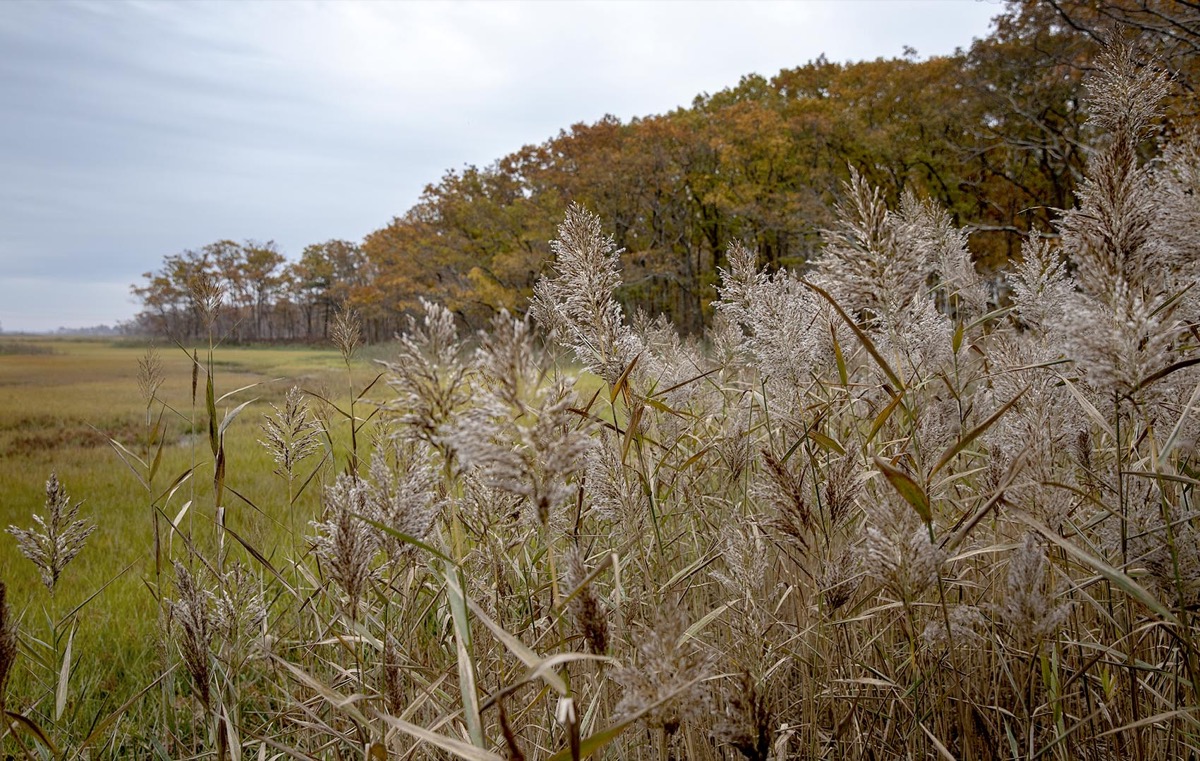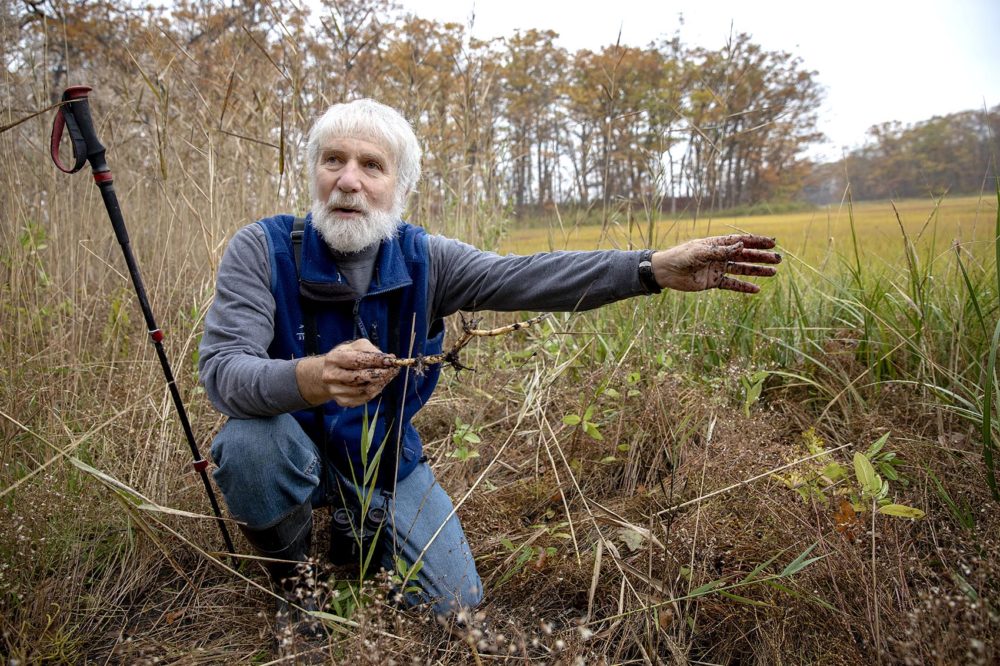The Complex Problem Of The Invasive Common Reed
3:52 minutes

This segment is part of The State of Science, a series featuring science stories from public radio stations across the United States. A version of this story, by Barbara Moran, originally appeared on WBUR in Boston.
Robert Buchsbaum walks into a salt marsh on Boston’s North Shore. Around him towers a stand of bushy-topped Phragmites australis, an invasive plant commonly known as the common reed. Or, as some call it: the all-too-common reed.
Buchsbaum kneels in the mud and begins to dig. Phragmites is an enemy that this regional scientist with the Massachusetts Audubon Society knows all too well.
The plant, which typically grows about 13 feet high, looms over native marsh plants, blocking out their sunlight. When Phragmites sheds its lower leaves, or dies, it creates a thick layer of wrack that keeps native plants from germinating. Its stalks clog waterways, thwarting fish travel. Salt marsh sparrows avoid them. The roots, or rhizomes, secrete a chemical that prevents other plants from growing, and they grow so deep they are nearly impossible to pull out.
That’s what Buchsbaum is kneeling in the mud at Rough Meadows Wildlife Sanctuary to demonstrate. He grabs a Phragmites root with both hands, leans back and pulls with all his might. Nothing. Phragmites isn’t going anywhere.
“It’s very resilient,” says Buchsbaum. “You need to keep after it, and you’re going to be doing it forever.”
But this stubborn bully of a plant might have a shot at redemption. A recent study from the Smithsonian Environmental Research Center found that the very traits that make Phragmites a tough invader—larger plants, deeper roots, higher density—enable it to store more carbon in marshy peat. And as climate change races forward, carbon storage becomes a bigger part of the ecosystem equation.
“We’re living in a high CO2 world,” says Ian Davidson, lead author on the Smithsonian study. “So it’s become pretty interesting to understand how much carbon is stored in the biosphere, and in particular types of habitats.”
Davidson is quick to say that his research doesn’t advocate removing native plants in favor of Phragmites.

“There’s fairly universal agreement that we should try to reduce and prevent invasions as much as we can. But there’s also the world we have right now,” he says. “[Carbon storage] is one factor that should be considered among many when managers are trying to make decisions about how to help the system function.”
While scientists have long studied carbon sequestration in forests and farmlands, says Davidson, they’ve more recently started to examine “blue carbon,” which is stored in marine habitats like marshes and mangroves. His study is one of the more recent to look at the differences in carbon storage between native and invasive coastal species. And while Davidson’s study is not definitive, its findings on Phragmites were surprising, and gave local ecologists food for thought.
“That paper was very interesting,” says Anne Giblin, a senior scientist and interim director of the Ecosystems Center at the Marine Biological Laboratory in Woods Hole. “[It] did a very nice job talking about the balance between having increased carbon storage, but perhaps having slightly lower ecosystem services for other things, such as biodiversity.”
Giblin says the tradeoffs are complicated. Phragmites gives off methane, a potent greenhouse gas. And the plant only stores carbon permanently when it decomposes into peat, and the peat is left alone. But Phragmites may offer another advantage in the face of climate change—since it builds up so much, it can buffer marshes against sea level rise and storm surges.
“In the mid-Atlantic where they are losing a lot of the marshes really quickly, there [are] discussions about whether or not they should be treating frag because it is one of the few plants that is keeping up with sea level rise,” says Nancy Pau, a biologist at the Parker River National Wildlife Refuge on Plum Island. “So those discussions are happening at kind of localized levels.”
No scientists are advocating for actually planting Phragmites, and Mass. Audubon, the state, the National Park Service and many other groups have active programs to combat it. But where the invader has already won, or has overtaken a mudflat or brownfield, some think it may best be left alone.
Back on the marsh, Mass. Audubon’s Buchsbaum says he bears the invader no ill will. But he doesn’t want to use it to combat climate change.
“Should we be depending on an invasive species, which causes a degradation to the habitat, to make up for our foibles of emitting too much carbon into the atmosphere?” asks Buchsbaum. “Is that the right approach to take, or should we be doing something to reduce our carbon footprint?”
But reducing our carbon footprint quickly enough to avoid the worst consequences of climate change won’t be easy. And it may mean opening our minds to some of our old enemies.
Barbara Moran is an Environment Correspondent at WBUR in Boston, Massachusetts.
JOHN DANKOSKY: And now it’s time to check in on the state of science.
SPEAKER 1: This is KERA News.
SPEAKER 2: For WWNO–
SPEAKER 3: St. Louis Public Radio–
SPEAKER 4: Iowa Public Radio News–
JOHN DANKOSKY: Yeah, local science stories of national significance– a New England salt marsh can certainly seem like a bucolic spot with those bushy reeds dotting the landscape. But those tall reed-like plants that we think of as quintessentially New England, and a big part of the marsh ecosystem, are actually an invasive species called phragmites. And it’s choking out life in the wetland. Phragmites is tough to get rid of, and recent efforts have gotten even more complicated because of climate change.
Here with that story now is Barbara Moran, environmental editor at WBUR in Boston. Hi, there, Barbara.
BARBARA MORAN: Hey. How are you doing, John?
JOHN DANKOSKY: Doing well. So there’s been a long campaign to get rid of phragmites across New England and elsewhere in marshy areas. Why? Why are people trying to get rid of them?
BARBARA MORAN: Yeah. It’s funny because it’s actually kind of a pretty plant. I know people would hate hearing me say that. But it’s sort of public enemy number one as far as invasive species in marshes. And salt marshes are a really important part of that New England ecosystem. And the phragmites is a really tough invader that can come and crowd out the native marsh species.
I talked to Liz Duff when I was researching this story. She’s been studying salt marshes for Mass Audubon for more than two decades. And she really laid out the case for why we should be getting rid of phragmites. And here’s a cut from her.
LIZ DUFF: When there’s less phragmites, it’s easier, say, for migrating birds to find a place to land. It’s easier for our native grasses to thrive. It competes for things like our golden rod, which is important food for migrating monarch butterflies. So there’s definitely disadvantages for having the phragmites around.
JOHN DANKOSKY: So this is why people have been trying to get rid of them for years. But now there’s some questions about whether or not we should just leave those phragmites in place. What are they finding?
BARBARA MORAN: Yeah, this is really interesting. So I should say it’s also phragmites is really, really hard to kill. You know like, when they try to kill it, they do stuff like cracking its neck open and dripping poison down with an eyedropper. Or they try flooding it. And it often just comes back. So it takes a lot of resources to try and kill it.
And the questions have been arising for the past couple of years about whether phragmites might– might actually provide some useful, you know, what they call ecosystem services, especially with growing concerns about climate change.
JOHN DANKOSKY: So what does it do? Why might it actually help us combat climate change?
BARBARA MORAN: Yeah, so it’s really interesting. A study came out of the Smithsonian last fall by a scientist named Ian Davidson. And he found, kind of ironically, that the same stuff that makes phragmites such a tough invader– the fact that it’s really tall, it has deep roots, it grows really close together– all these things actually make it sequester carbon better than the native species.
So phragmites can take carbon out of the atmosphere. And when it decomposes into peat, it actually can sequester carbon better. There’s also this other evidence that phragmites, just because it’s so bulky, there’s such biomass, that it can buffer these marshes against sea level rise.
So these are a couple sort of maybe pluses for this invasive species that people are starting to sort of look at this plant a little differently.
JOHN DANKOSKY: So maybe make friends with the enemy over time, the enemy that they’ve been trying to get rid of for all these years?
BARBARA MORAN: Exactly. I know. And they’re not quite there yet. I mean, everybody was very quick to say, well, don’t go out and plant phragmites. We’re not there yet. Biodiversity is still the most important thing for marshes.
But they’re starting to talk. We’re living in this really high CO2. World climate change is advancing more quickly than expected. And we’re really going to have to start looking at things in a different way as we go forward maybe.
JOHN DANKOSKY: Barbara Moran is environmental editor at WBUR in Boston. She’s been following this story for us. Barbara, thanks so much for joining us. I appreciate it.
BARBARA MORAN: Thanks. It was great.
Copyright © 2019 Science Friday Initiative. All rights reserved. Science Friday transcripts are produced on a tight deadline by 3Play Media. Fidelity to the original aired/published audio or video file might vary, and text might be updated or amended in the future. For the authoritative record of Science Friday’s programming, please visit the original aired/published recording. For terms of use and more information, visit our policies pages at http://www.sciencefriday.com/about/policies/
Katie Feather is a former SciFri producer and the proud mother of two cats, Charleigh and Sadie.
John Dankosky works with the radio team to create our weekly show, and is helping to build our State of Science Reporting Network. He’s also been a long-time guest host on Science Friday. He and his wife have three cats, thousands of bees, and a yoga studio in the sleepy Northwest hills of Connecticut.